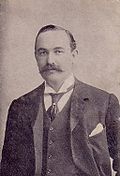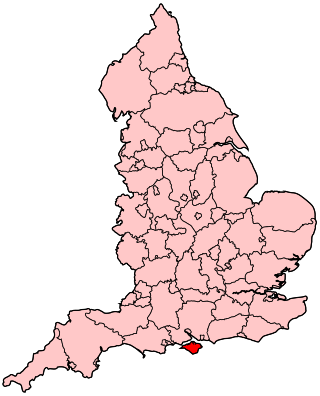Top Qs
Timeline
Chat
Perspective
Isle of Wight (UK Parliament constituency)
Parliamentary constituency in the United Kingdom, 1832-2024 From Wikipedia, the free encyclopedia
Remove ads
Isle of Wight (/waɪt/ WYTE)[1] was a constituency[n 1] that was last represented in the House of Commons of the UK Parliament from 2017 until 2024 by Bob Seely, a Conservative.
Created by the Great Reform Act for the 1832 general election, it covered the whole of the Isle of Wight. It had the largest electorate of any constituency at the 2019 general election.[n 2]
Following the 2023 Periodic Review of Westminster constituencies, the constituency was abolished for the 2024 general election. The island was divided into two constituencies, Isle of Wight East and Isle of Wight West.[2]
Remove ads
Boundaries
Summarize
Perspective
The Isle of Wight had been a single seat of the House of Commons since 1832. It covered the same land as the ceremonial county of the Isle of Wight and the area administered by the unitary authority, Isle of Wight Council: a diamond-shaped island with rounded oblique corners, measuring 22.5 miles (36.2 km) by 13 miles (21 km), the Needles and similar small uninhabitable rocks of very small square surface area. The island is linked by ferry crossings from four points (five points if counting Cowes and East Cowes separately) to three points in Hampshire: Lymington, Southampton and Portsmouth.
Its electorate of 113,021 at the 2019 general election[3] was the largest in the UK, more than 50% above the UK average: 73,181,[3] and five times the size of the smallest seat: Na h-Eileanan an Iar, formerly known as the Western Isles.[4]
One or two seats problem
The reviews of the Boundary Commission for England since 1954 have consulted locally on splitting the island into two seats (and included occasional proposals for a seat crossing the Solent onto the mainland) but met an overall distaste by the independent commissioners and most consultees and consultation respondents. The consensus of varying panels of Boundary Commissioners, party-interested and neutral commentators is that the island would be best represented by one MP. The Commissioners did make mention perfunctorily of their duty by law to avoid such an extent of malapportionment (termed by most commissioners "leaving the island somewhat oversized"). One problem the independent body cited in 2008 was a difficulty of dividing the island in two in a way that would be acceptable to all major interests. The arbitrary division line problem is routinely encountered in those council areas which have no rural elements or natural divides.[5]
Eventually, under the Parliamentary Voting System and Constituencies Act 2011, which proposed that the total number of constituencies in the UK Parliament should be reduced from 650 to 600, it was specified that the Isle of Wight should comprise two "protected" seats, meaning that their electorates did not have to be within the statutory range of ±5%. The 2011 Act was amended by the Parliamentary Constituencies Act 2020 which reversed the decrease in the total number of seats but retained the two protected seats for the Isle of Wight.
2024 boundary changes

Under the 2023 Periodic Review of Westminster constituencies which came into effect for the 2024 general election, the Boundary Commission for England proposed splitting the island into Isle of Wight East (electorate 56,805) and Isle of Wight West (electorate 54,911).[6][7][8][9][10]
- Isle of Wight East will include the communities of Ryde, Bembridge, Brading, Sandown, Shanklin and Ventnor;
- Isle of Wight West will include the communities of Newport, East Cowes, Cowes and Freshwater.
Remove ads
History
Summarize
Perspective
Before the Reform Act 1832 (apart from the First Protectorate Parliament (1654–1655), when a whole island constituency existed) the island was usually represented by three Parliamentary boroughs: Newport, Newtown, and Yarmouth, each electing two MPs. The county electorate of the island, which included freeholders qualified by property, was represented by the two MPs for Hampshire.[11] The Reform Act abolished the Newtown and Yarmouth parliamentary boroughs, and a single-member county division of Hampshire was created for the island. The separate and overlapping Newport representation was reduced to one MP in 1868[12] and finally abolished in 1885.[13] Since then, the whole of the Isle of Wight has been represented by one constituency.
The constituency has traditionally been a battleground between the Conservatives and the Liberal Democrats and their predecessors. The seat was held by a Liberal from 1974 until 1987,[14][15][16] a Conservative until 1997, a Liberal Democrat until 2001,[16][17] and a Conservative since then.[17]
At the 2015 election, the incumbent Conservative scored one of his party's largest swings against the Liberal Democrats whose candidate finished in fifth place.
In the 2017 general election, the Labour candidate gained second place with the party's best result since 1966. Nick Belfitt, the Liberal Democrat candidate, became the youngest ever candidate to stand for the seat at the age of 23.[18]
At the December 2019 general election, Labour came second, marginally increasing the party's vote total and share of the poll compared to 2017. The Liberal Democrats agreed to stand aside and support the Green Party candidate as part the Unite to Remain agreement between the two parties and Plaid Cymru involving 60 constituencies in England and Wales, with the purpose of increasing the chances of candidates who supported remaining in the European Union.[19]
Remove ads
Members of Parliament
Pre 1832
- 1654: Lord Lisle; William Sydenham
- 1830–1831: Horrace Twiss
Since 1832

Elections
Summarize
Perspective

Elections in the 2010s
Elections in the 2000s
Elections in the 1990s
Elections in the 1980s
Elections in the 1970s
Elections in the 1960s
Elections in the 1950s
Elections in the 1940s
General Election 1939–40
Another general election was required to take place before the end of 1940. The political parties had been making preparations for an election to take place from 1939 and by the end of this year, the following candidates had been selected;
- Conservative: Peter Macdonald
- Labour: Robert Arthur Lyster
- Liberal: Helen de Guerry Browne
Elections in the 1930s
Elections in the 1920s
Elections in the 1910s
Another General Election was required to take place before the end of 1915. The political parties had been making preparations for an election to take place and by July 1914, the following candidates had been selected;
- Unionist: Douglas Hall
- Liberal: Godfrey Baring

Elections in the 1900s


Elections in the 1890s
Elections in the 1880s
- Caused by Webster's appointment as Attorney General of England and Wales.
Elections in the 1870s
- Caused by Simeon's death.
Elections in the 1860s
Elections in the 1850s
- Caused by Simeon's resignation after he converted from Anglicanism to Catholicism.[62]
Elections in the 1840s
Elections in the 1830s
Remove ads
See also
Notes
- A county constituency (for the purposes of election expenses and type of returning officer)
- As with all constituencies, the constituency elects one Member of Parliament (MP) by the first past the post system of election at least every five years.
References
External links
Wikiwand - on
Seamless Wikipedia browsing. On steroids.
Remove ads


